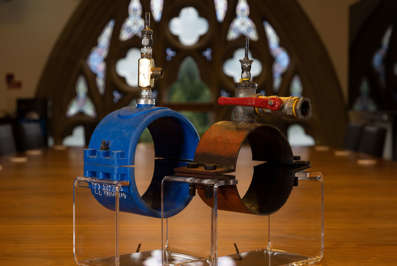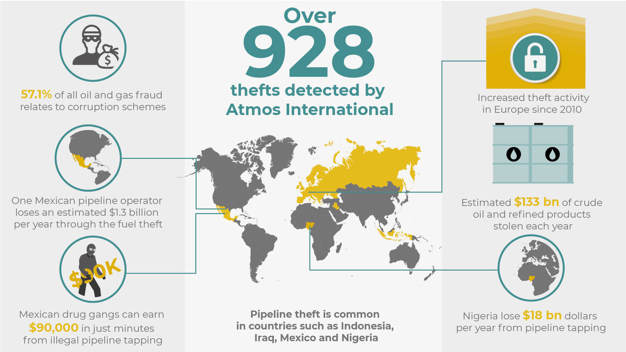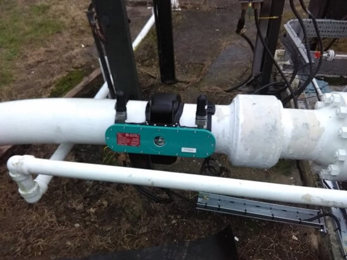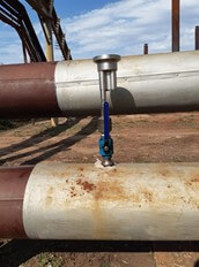Pipeline theft: A serious global problem
Pipeline theft continues to be a serious global problem, with an estimated $133 billion worth of crude oil and refined products stolen or adulterated every year1. However, a lot of progress has been made with theft detection systems that are contributing significantly to the early detection and location of illegal tapping points. Here our theft detection expert, Harry Smith answers some of the key questions we have been asked, including:
- Question 1: What are some of the more recent types of theft you're seeing happen?
- Question 2: Do you see the same types of theft happening across all regions?
- Question 3: Isn't it better to just have people out patrolling rather than spending money on technology if the thieves keep changing their tactics?
- Question 4: What's your advice for combining leak and theft detection?
- Question 5: How effective is hardware in helping with the detection of thefts?

Question 1: What are some of the more recent types of theft you're seeing happen?
The two main types of theft we’re seeing happen on pipelines use clamp or welded taps. Clamp taps are the most common method and used on pipelines of up to 20 inches. The clamps are usually made from steel plates with a valve pre-welded in one of the parts. Leaks often occur when low quality material and seals are used.

Figure 1: Examples of clamp taps both found on two different Costa Rican pipelines
In the last few years welded taps have started becoming more popular. They are often used on pipelines over 20 inches because a clamp is too heavy to handle, however they are also used on pipelines of a smaller diameter. It is a method that is extremely dangerous as there’s a high risk of igniting the product. In the media we’ve seen several cases of pipeline explosions and fires caused by this technique.
Both clamp and welded tapping points weaken the integrity of the pipeline. It means that leaks and ruptures are more likely to occur. With the pipeline weakened there’s also a great risk to the pipeline operators, as well as the environmental implications of product leaking out the pipeline.
Question 2: Do you see the same types of theft happening across all regions?
Pipeline theft activity varies from country to country. Although the need for it may differ across countries and markets, we do see similarities and trends in the methods and techniques used by thieves.
It can be a deeply entrenched problem in some countries facing ongoing political, social and economic issues in these cases, the problem can be far reaching with organized criminal gangs running a sophisticated operation. One pipeline operator in Mexico loses an estimated $1.3 billion per year through the fuel theft carried out by groups like Mexican drug cartels1. Nigeria is another country hit hard by theft activity, with an estimated $18 billion lost per year1.

Figure 2: Infographic demonstrating global impact of pipeline theft
But theft really can happen anywhere. We recently detected a theft in Europe using our Atmos Wave Flow software and Atmos Eclipse hardware. The thieves had been running a very sophisticated operation and had been getting bolder, stealing from the pipeline for three nights on one occasion. Our client found the tapping point around 40 meters from our calculated theft location.
Question 3: Isn't it better to just have people out patrolling rather than spending money on technology if the thieves keep changing their tactics?
The patrol of pipelines is one of the strategies that can be used to aid theft detection. However, it’s simply not cost effective or practical to do this as the sole method. Pipelines can be thousands of kilometers long. Imagine the amount of resource you’d need to patrol regularly enough to spot theft activity or leaks?
The best approach is a multi-layered approach, using a variety of theft detection methods. So, patrol of the pipeline, whether it’s done by people, dogs or drones could be just one of them.
Adequately training pipeline operators and implementing theft detection technology are other important methods to create this multi-layered approach.
Technology is always evolving to become more intelligent when it comes to pipeline theft detection. Atmos Wave Flow is a good example of this and uses a multi-method approach with negative pressure wave (NPW) and volume balance. The algorithms compensate for variations so that corrections are made for any measurement errors such as meter drift.
In our experience coupling these different methods with patrol gives the most robust approach to theft detection and tapping point location.
Question 4: What's your advice for combining leak and theft detection?
It’s great to have a system that can detect both leaks and theft activities. However, it is also important to consider that certain methods may be better at detecting theft activities than others.
Theft activity is often below the flow meter accuracy and repeatability level, for that reason the negative pressure wave method is preferable, this is due to its high acquisition rate and use of analog pressure transmitters. This method provides the higher level of sensitivity needed to detect smaller thefts, using the 60 Hz sample rate.
You can also use a theft detection service, like Atmos Theft Net. This is where the data is analyzed by a team of expert engineers offline to detect thefts below the sensitivity level of online systems without the concern of false alarms. This sensitivity level is usually below 0.5% nominal flow-rate.
Question 5: How effective is hardware in helping with the detection of thefts?
Atmos International (Atmos) customers have experienced challenges such as lack of instrumentation, power or communication, housing for instrumentation, yet needing to improve sensitivity. New hardware is a way of overcoming these issues. We have developed instrumentation like Atmos Eclipse and Atmos Odin for this reason.
In situations where there’s a long stretch of pipeline in an extremely remote or high consequence area, hardware can add another layer of reliability.
Hardware like Atmos Eclipse are non-intrusive and measure flow, pressure and temperature to help detect theft activity. The internal cellular, radio and standard RS485 and ethernet communications enable Atmos Eclipse to provide real-time data to pipeline operators. Adding a solution like this not only makes your approach more reliable but adds more sensitivity.


Figure 3: Atmos Eclipse and Atmos Odin in operation
Alternatively, you could also use hardware like Atmos Odin. This is a battery powered pressure sensor that acquires its data locally, so it is excellent for areas with no power or communications. This unit can also be buried to avoid tampering. The internal GPS in Atmos Odin acquires an accurate location and time lock while the unit is transported to the site. The device continues to collect data for up to 21 days. Data collected is analyzed by Atmos Theft Net engineers, to effectively detect and locate any theft activity. This unit recently detected and located a theft in Africa.
References
1https://oilmanmagazine.com/article/oil-theft-a-frightening-international-perspective/
